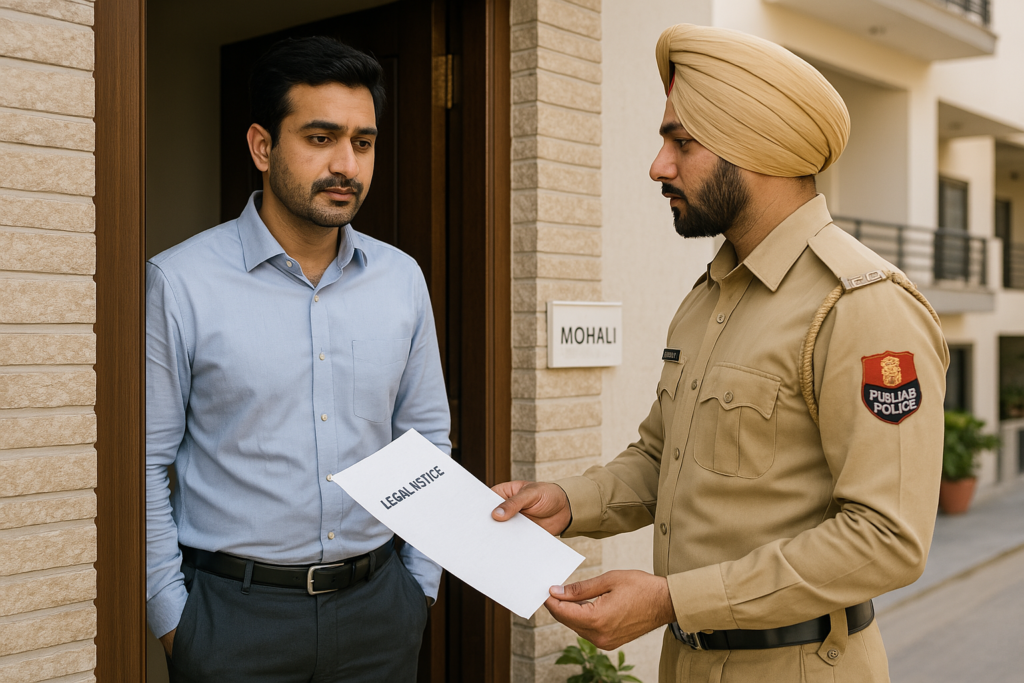If you’ve received a police summons or notice in Mohali, it’s crucial to understand your legal rights before responding. Whether you’re a student, working professional, or businessperson, a notice from the police can feel intimidating. But with a solid understanding of India’s new criminal law framework, you can protect yourself and respond lawfully. This article explains the types of police communications, relevant sections under Bharatiya Nagarik Suraksha Sanhita (BNSS), 2023, and your rights under the Indian Constitution. Whether you’re seeking help from criminal lawyers in Chandigarh, criminal defense advocates, or high court lawyers, this guide gives you clarity.
What is a Police Summons or Notice?
A police notice or summons is an official communication requiring your appearance or cooperation in an investigation. While both serve different legal functions, they are tools used by the police to gather evidence or proceed with investigations.
Difference Between Notice and Summons
Police Notice Under Section 35 of BNSS, 2023
Under Section 35 of the Bharatiya Nagarik Suraksha Sanhita (BNSS), 2023, a police officer may issue a notice of appearance when an offence is suspected, but immediate arrest is not required.
Key features of Section 35 notice:
- Issued in cases where the offence is cognizable but not serious enough to justify arrest.
- Ensures protection against unnecessary arrests.
- The person must comply and appear at the police station as instructed.
This section replaces Section 41A of the old CrPC.
Police Summons Under Section 66 of BNSS, 2023
Section 66 of BNSS, 2023 (formerly Section 61 CrPC), empowers police to issue a summons to appear for questioning or legal proceedings.
Key points:
- It is a formal legal requirement.
- Ignoring the summons could result in further action or arrest.
- Must be in writing and served appropriately.
Legal Framework: New Sections Replacing CrPC
Section 35 – Notice of Appearance
As per Section 35 of BNSS, when arrest is not warranted, police can issue a notice to appear. It is widely used in:
- Matrimonial disputes
- Business fraud cases
- Cybercrime allegations
Legal Reference:
The Supreme Court in Arnesh Kumar v. State of Bihar (2014) emphasized safeguards against arbitrary arrests, now legally reflected in Section 35.
Section 90 – Summons to Produce Documents or Evidence
This section replaces the earlier Section 91 CrPC, enabling authorities to demand specific documents or items necessary for investigation or trial.
Applies to:
- Companies (for financial records)
- Individuals (for personal documents)
- Institutions (e.g., CCTV footage)
Section 81 – Summoning a Witness
Replacing Section 160 CrPC, Section 81 BNSS allows a police officer to call upon witnesses for investigation.
Important safeguards:
- Applicable to men below 65 years and women above 18 years.
- Limited by jurisdiction – only local or nearby individuals can be summoned.
Article 20(3) of the Indian Constitution
Your constitutional right against self-incrimination continues unchanged. Under Article 20(3):
- You cannot be compelled to testify against yourself.
- You may refuse to answer questions that would implicate you.
Procedure After Receiving a Police Notice or Summons
Step 1: Confirm Authenticity
Check:
- Official seal and letterhead
- Clear identification of the investigating officer
- Section references (e.g., Section 35 BNSS)
Step 2: Understand the Purpose
Identify:
- Whether you’re being called as a witness or accused
- The nature of the complaint
- What information is expected
Step 3: Seek Legal Counsel
It is advisable to consult criminal defense lawyers in Chandigarh before responding. They help with:
- Drafting responses
- Accompanying you during appearances
- Preparing anticipatory bail if needed
Step 4: Respond Within Timeframe
Ignoring the notice can result in:
- Warrant under Section 85 BNSS (previously Section 70 CrPC)
- Coercive action including arrest
Your Legal Rights When Facing a Summons or Notice
Right to Representation
You have the right to be assisted by a legal professional. Consult:
- Criminal advocates in Chandigarh
- High court lawyers (for complex matters)
- Defense lawyers with experience in BNSS provisions
Right to Remain Silent
Article 20(3) gives you the right to not answer self-incriminating questions. This includes:
- Verbal statements
- Written confessions
- Digital communications
Right to Be Protected Against Arbitrary Arrest
Section 35 ensures that arrest cannot be made unless:
- You fail to appear
- The officer records valid, written reasons for arrest
This is a major procedural safeguard under BNSS.
Practical Scenarios in Mohali Under BNSS
Scenario 1: 498A Complaint
A man receives a Section 35 notice in a matrimonial cruelty complaint. He must appear or risk coercive action. Criminal lawyers in Chandigarh can help pre-emptively apply for anticipatory bail.
Scenario 2: Startup Receives Summons
A Mohali-based tech firm receives a Section 90 summons to provide financial data. The company must legally comply, and may request time via its counsel.
Scenario 3: Cyber Crime Investigation
A college student is called as a witness under Section 81 BNSS in a cyberbullying case. The student must appear but has the right to legal advice and non-self-incrimination.
Consequences of Ignoring Police Summons or Notice
Legal Ramifications
Non-compliance may lead to:
- Warrant under Section 85 BNSS
- Possible arrest with written justification
- Fine or legal proceedings under Section 194 of Bharatiya Nyaya Sanhita (BNS) for obstruction of justice
Presumption of Guilt
In certain cases, non-cooperation can:
- Weaken your legal position
- Influence how courts view your intent
Whether it’s a Section 35 appearance, Section 90 summons, or anticipatory bail under Section 483, legal representation is crucial.
Police notices and summons in Mohali must not be ignored—but they should not be feared either. With the new criminal law codes, including BNSS, 2023, individuals have greater procedural protection. Understand your obligations under Sections 35, 66, 81, and 90 BNSS, and consult with a qualified criminal defense advocate in Chandigarh before responding.
FAQs on Police Summons or Notice in Mohali
1. What is the difference between a police notice and a police summons under BNSS?
A Section 35 notice is a non-arrest summons to appear, usually in preliminary stages. A Section 66 summons is a formal, legally binding document requiring appearance. Ignoring the latter has stronger legal consequences.
2. Can I be arrested if I receive a Section 35 notice?
Not immediately. Arrest without warrant can happen only if:
- You fail to appear
- Police officer records reasons as per Section 35(3) BNSS
3. Do I need a lawyer to respond to a notice in Mohali?
It’s highly recommended. Criminal advocates or high court lawyers in Chandigarh can assess if the notice is lawful and help you respond properly.
4. Can a notice or summons be quashed?
Yes. The High Court can quash a notice or summons under Section 484 BNSS if it’s issued:
- Without jurisdiction
- With malafide intent
- In violation of procedural safeguards
5. What should I do if I live outside Mohali and receive a notice?
Consult a local criminal lawyer in Chandigarh. Depending on the case, your lawyer may:
- File a reply
- Request exemption from appearance
- Appear on your behalf

